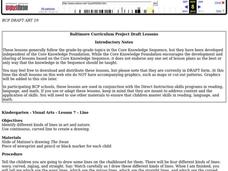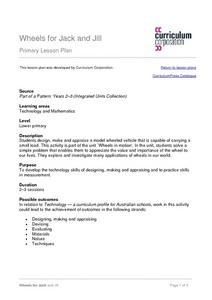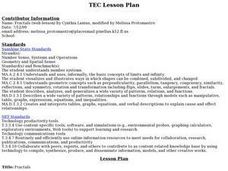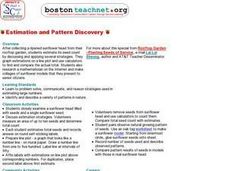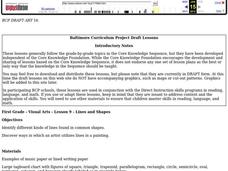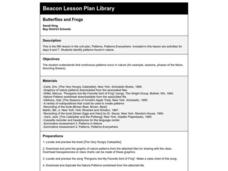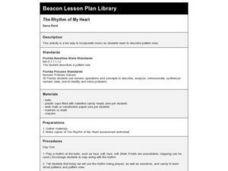Curated OER
Visual Arts
Students identify different kinds of lines in art and nature. They use continuous, curved line to create a drawing.
Curated OER
Symmetry
Students explore symmetry. In this geometry lesson, student identify and define bilateral symmetry, radial symmetry, pentagonal symmetry, hexagonal symmetry, and cubic symmetry. Students construct examples of these types of symmetry and...
Curated OER
Animals Finding Rice Paddies
Fourth graders examine the animals who live in rice paddies and create a chart. In this rice lesson, 4th graders link the types of animals living in each ecosystem with a bar graph. Students use colored bars to show...
Curated OER
How Machines Help Us Stay Healthy
Students visit different departments at a local hospital to see how machines help peoples such as the CAT scan machine. They build a model of such a machine that shows how patients are moved in and out of the machine.
Curated OER
A World of Symmetry
Middle schoolers identify lines of symmetry. In this symmetry lesson, students create objects and identify their lines of symmetry. They answer questions about lines of symmetry. Middle schoolers cut shapes out of...
Curated OER
Swim with the Fishes: Creating Animated Aquariums
Students using a Flash unit create a scene for the fish to swim about in. They create a fish using various software tools of their choice. Students then animate the fish across the screen. They develop a background scene, draw a fish...
Curated OER
Principles Of Flight: Wings That Spin
Students discover how flight is possible. In this physics lesson, students investigate the properties of a blimp and gyro-copter, comparing rotating wings and fixed wings of aircraft. Students create their own model aircraft...
Curated OER
Wheels for Jack and Jill
Learners design, make and appraise a model wheeled vehicle that is capable of carrying a small load. This activity is part of the unit `Wheels in motion'.
Curated OER
Spending Plans
Students explore the concept of dividing their money into categories, namely "save," "spend," and "share." They engage in activities that help them explain that money is limited in quantity and must be divided for different purposes.
Curated OER
What are Fractals?
Middle and high schoolers identify and analyze fractals and research information using the Internet to locate information about them. They look at fractals in relation to nature and other real world situations. Pupils create several...
Curated OER
Estimation and Pattern Discovery
Students collect sunflower heads from their community garden. They estimate its seed count using different strategies. They graph their estimations on a graph and use calculators to find the actual total.
Curated OER
Once in a Blue Moon
Third graders identify the phases of the moon. They use technology to access websites on the Internet dealing with the moon.
Curated OER
FOOTSTEPS IN TIME
High schoolers measure and correlate their foot lengths and body heights, then use this data to estimate height of Laetoli hominids. They use metric measurement and graphing to determine these heights.
Curated OER
Geometry in Nature
Students examine how the circumference, diameter, and the relationship of Pi of a circle are related. They count the summer rings of a tree to determine its growth.
Curated OER
The Dragon Curve Fractal
Learners identify the properties of a dragon curve. In this geometry instructional activity, students identify sequences and patterns as they solve fractals. They investigate patterns found in nature.
Curated OER
Fractal and the Dragon Curve
Students explore Fractal designs. In this geometry lesson, students observe the different polygons created in nature and relate it to math. They define polygons on planes and rotate polygons about a point.
Asian Art Museum
Create Your Own Samurai (Breastplate) Armor
Your class is going to love this activity. They get out their rulers, cardboard, and paints as they make Samurai breastplates. The simple art lesson lends itself to many different subjects such as, math/measurement, world history, and...
Curated OER
What do two-dimensional tessellations look like? Where in art can they be found?
Students explore the world of art and culture, including the works of M.C. Escher. They identify and create original tessellations. Students use a wealth of interactive multimedia applications. They explore the artistic representations...
Curated OER
Lines and Shapes
First graders identify different kinds of lines found in common shapes. They discover ways in which an artist utilizes lines in a painting.
Curated OER
Population Biology - Biology Teaching Thesis
Young scholars explore the effects of different density-dependent and density-independent factors on population growth. They explore how the interactions of organisms can affect population growth. Students explore the pattern of...
Curated OER
Water Pressure Blaster
Third graders complete an experiment to introduce them to the concept of water pressure. In this water pressure lesson plan, 3rd graders create pressure in a water bottle and observe the force of water that is created.
Curated OER
The Rhythm of My Heart
First graders describe pattern rules. They use the rhythm being played on a bell and candy hearts to explore patterns and pattern rules. This is an especially good instructional activity to use around Valentine's Day.
Curated OER
Tessellations
Fifth graders investigate the relationship between math and art by examining patterns and polygons.They examine how polygons make up the patterns that form tessellations, and determine tessellations that occur in nature. Finally, they...
